How to enhance warehouse efficiency with real-time Robotics Automation example implementation with Spring Boot Microservices
In this fast-paced world, just-in-time robotic automation is revolutionizing industries through efficiency, precision, and scalability. Developers can build robust and responsive bot automation systems by leveraging Spring Boot microservices. In this blog, Data warehouse consulting has explained in detail the integration of robotic automation and Spring Boot microservices through a real-time example.
Spring Boot Microservices
Spring Boot is the process of building self-contained, production-grade Spring-based applications. As you will know, microservices are an architecture that breaks applications into small, loosely coupled services that can be developed, deployed, and tested independently. They work without human intervention. These tasks range from simple and repetitive to complex tasks that require precision and flexibility.
What is Robotics Automation?
Robotics automation is a process that involves using robots to perform tasks without human intervention. These tasks may include simple ones, or repetitive actions to complex operations requiring high precision and adaptability.
Why Combine Spring Boot Microservices with Robotics Automation?
- Scalability: Microservices architecture allows individual elements of the robotic system to extend themselves
- Flexibility: Decoupled services allow developers to modify or change parts of the system without affecting the entire system.
- Real-time Processing: Microservices architecture allows individual elements of the robotic system to extend themselves.
- Flexibility: Real-time performance: Spring Boot’s support for reactive programming (Spring WebFlux) allows the system to process large amounts of data in real-time.
Real-World Example: Automated Warehouse Management System
Let’s consider an automated warehouse management system where robots handle inventory storage, retrieval, and sorting. This system needs to process real-time data to ensure efficient operation.
- Robot Operation: When an order is processed, the Robotic Control Service directs the robot to retrieve or store items.
- Inventory Update: The Inventory Service will update the stock levels in the database.
- Order Processing: The Order Processing Service helps in coordination! It coordinates the robot’s operation and updates the inventory.
- Real-time Notifications: The Notification Service is used to send real-time updates about any updates and these updates include order status and inventory levels updates to stakeholders.
Integrate robotic automation with Spring Boot microservices to create a competitive, flexible, and efficient system that can work out of the box. These standards not only improve the performance of automation systems but also enable them to adapt to needs and perform seamless measurements.
Customize microservices to meet real-world needs. Leveraging Spring Boot microservices for such tasks ensures that each element of the system is modular, self-scalable, and easy to manage
The below example shows a complex robotic automation system over time in a warehouse environment, with well-planned parts such as receiving, cutting, maintenance, and breaching.
Many organizations are working together to develop products, manage inventory, manage robots, manage ordering processes, and provide feedback. Below is a description of the design, including the components, their interactions, and overall functionality.
Architecture Diagram: Advanced Real-Time Robotics Automation with Spring Boot Microservices
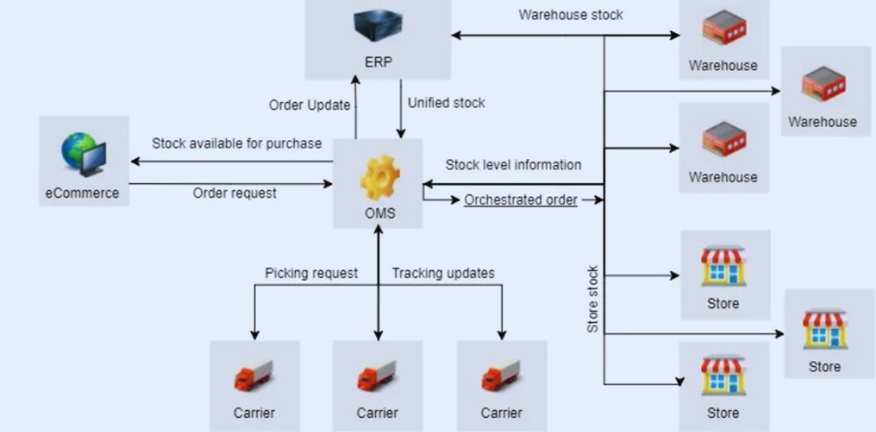
- Robotic automation in a manufacturing environment requires a robust, scalable, and highly available architecture. Leveraging Spring Boot microservices for such tasks ensures that each element of the system is modular, self-scalable, and easy to manage.
- This example shows a complex robotic automation system over time in a warehouse environment, with well-planned parts such as receiving, cutting, maintenance, and breaching.
- Many organizations are working together to develop products, manage inventory, manage robots, manage ordering processes, and provide feedback.
- Below is a description of the design, including the components, their interactions, and overall functionality.
- Designing a warehouse robotics automation system with Spring Boot microservices is not that easy but it includes multiple components that work together to optimize RDC/warehouse operations and then manage inventory updates and control robots as well as process orders and then provide feedback mechanisms.
I have explained about the system design that includes architectural components, their interactions, and overall workflow.
System Architecture anatomy
1. Microservices Overview
- Inventory Service: Manages warehouse inventory, including item quantities, locations, and stock levels.
- Order Processing Service: Handles incoming orders, processes them, and manages their statuses.
- Robot Control Service: Sends commands to robots for picking and transporting items.
- Robot Status Service: Monitors and reports the status of robots, such as their location, battery levels, and operational status.
- Feedback Service: Collects feedback from users and systems regarding warehouse operations, robots, and order processing.
- Feedback Processing Service: Processes the feedback and stores it in a database for analysis.
2. Message Broker
- Apache Kafka: Acts as the central message broker to facilitate communication between services. It handles commands, notifications, and status updates.
3. Database Layer
- MongoDB: Used for storing feedback and status information.
- Relational Database: This can be used in other services like inventory mgmt and order processing as in these services we may require complex transactions depending on the data structure.
4. Robots
- Physical robots will be deployed in the rdc/warehouse to perform various tasks such as picking the items packing and finally transporting items.
5. User Interface
- A web-based dashboard or mobile application for warehouse operators to manage inventory, monitor robot performance, and receive feedback.
Workflow
1. Order Processing
- The Order Processing Service receives an incoming order via a REST API or webhook.
- It checks the Inventory Service to ensure the items are in stock.
- If items are available, it sends commands to the Robot Control Service to initiate picking.
2. Robot Control
- The Robot Control Service receives commands (e.g., “Pick item X from location Y”).
- It publishes these commands to a Kafka topic (e.g., robot commands).
- Robots subscribe to this topic and execute the commands, moving to the specified locations and picking items.
3. Status Updates
- As robots perform tasks, they send status updates back to the Robot Status Service.
- The Robot Status Service publishes these updates to a Kafka topic (e.g., robot status).
- Other services (like the Order Processing Service) can subscribe to this topic to get real-time updates.
4. Feedback Loop
- Users or systems provide feedback through the Feedback Service.
- Feedback includes comments on robot performance, inventory issues, or order fulfillment.
- The Feedback Service sends feedback messages to a Kafka topic (e.g., feedback topic).
- The Feedback Processing Service consumes these messages, processes them, and stores them in MongoDB for further analysis.
5. Monitoring and Reporting
- An optional dashboard or reporting service can subscribe to relevant Kafka topics to visualize real-time data on order processing, robot statuses, and feedback metrics.
- This interface allows warehouse managers to make informed decisions based on system performance and feedback.
Key Design Considerations
- Scalability: Microservices architecture allows individual services to scale themselves based on their workloads. For example, if order processing traffic increases, you can scale the order processing service without affecting other factors.
- Resilience: Using libraries like Resilience4j to implement power generation and replication can help effectively manage failures and increase resilience.
- Decoupling: Use Kafka as a distributor to decouple services so they can evolve independently without interfering with each other.
- Real-Time Processing: The system supports real-time data processing to get real-time updates of bots and orders using Kafka.
- Feedback Analysis: Feedback not only collects user inputs but also defines performance indicators that will help improve the product.
- Security: Use security measures such as OAuth2 or JWT for API authentication and authorization to ensure that only authorized users and systems can access sensitive information.
The system consists of several microservices:
- Robot Control Service: This service manages all robot operations.
- Inventory Management Service: This handles inventory updates and inv data.
- Order Processing Service: This service manages orders and coordinates with the robot control.
- Notification Service: This service sends real-time updates to stakeholders and other 3rd party systems.
- Authentication Service: This service is purely for security and manages user authentication and authorization.
- Monitoring Service: This one provides system metrics and health checks.
- Logging Service: This class is used for centralized logging to track and for debugging.
Step-by-Step real-time Implementation
1. Setting Up the Project
Create a multi-module Maven project with separate modules for each service. Include the necessary dependencies for each module.
Parent POM

2. Authentication Service
Implement JWT-based authentication for securing the microservices.
SecurityConfig.java

3. Robot Control Service
This service will manage robot operations, interacting with the robots via a messaging system (Kafka).
ROperationController.java
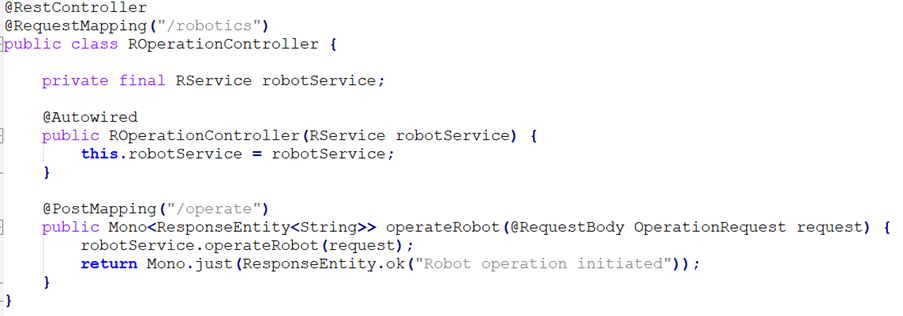
RService.java

4. Inventory Management Service
- This service manages inventory data using JPA for persistence and WebFlux for reactive endpoints.
InventoryMgmtController.java
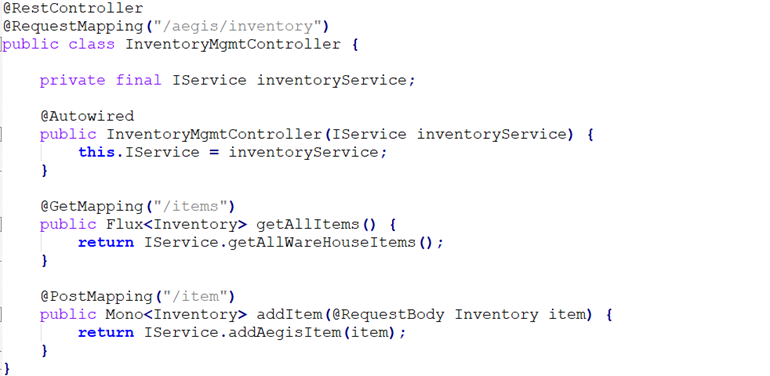

5. Order Processing Service
- This service coordinates order processing and interacts with both the Inventory and Robot Control services.
OrderMgmtController.java

OrderInfoService.java

6. Notification Service
- This service uses WebFlux to send real-time notifications to users.
AegisRDCNotificationController.java

AegisRDCNotificationService.java

7. Monitoring and Logging
Prometheus and Grafana
Integrate Prometheus and Grafana for monitoring metrics.

ELK Stack for Centralized Logging: Configure Logstash to receive logs from the microservices and send them to Elasticsearch.
logstash.conf

8. Deploying with Docker and Kubernetes
- Create Dockerfiles for each microservice and use Kubernetes for orchestration.
Dockerfile

Kubernetes Deployment

Here is a complete example implementation of managing a warehouse using Spring Boot microservices and Kafka streams to process large amounts of data to enhance robot automation.
Functionality
AegisNotificationSvcAegisNotificationSvcFunctionalityAegisNotificationSvcAegisNotificationSvc:
- This service is responsible for sending commands to robots working in the warehouse. When a command is passed to RobotControlService, the command is converted to a Kafka message and published to the Kafka topic.
AegisNotificationSvcAegisNotificationSStreamStreamBridgeAegisNotificationSvcAegisNotificationSvc:
- StreamvcBridgeAegisNotificationSvcAegisNotificationSvc:
- StreamvcBridge is an electronic component in an electronic component that refers to Stream topics.
AegisNotificationSvcAegisNotificationSvcFunctionalityAegisNotificationSvcAegisNotificationSvc:
- This service manages the order service. When a new order is placed, OrderService completes the order by checking the availability of all items in the order. It orders the required items to be collected from the location. (For example, when placing an order) InventoryService determines how much is needed in the warehouse.
1. AegisNotificationSvcAegisNotificationSvcInventory CheckAegisNotificationSvcAegisNotificationSvc:
- InventoryService Check if the product is in stock and send the result back to OrderService. AegisNotificationSvcAegisNotificationSvcRobot CommandAegisNotificationSvcAegisNotificationSvc:
- If the item is available, the OrderService will create a command that allows the robot to retrieve the item. . AegisNotificationSvcAegisNotificationSvcRobot ExecutionAegisNotificationSvcAegisNotificationSvc:
- A robot that subscribes to Kafka topics receives commands and performs tasks such as fetching and loading. Scalable, real-time communication between programs increases the overall efficiency of warehouse operations.
RobotMgmtControlApplication.java

RobotWareHouseOperationController.java

RService.java

RobotWareHouseOperationRequest.java

kafka/KafkaProcessor.java

IServiceImpl
InventoryMgmtApplication.java
@SpringBootApplication
@EnableBinding(InventoryStreamProcessor.class)
public class InventoryMgmtApplication {
//main method
}
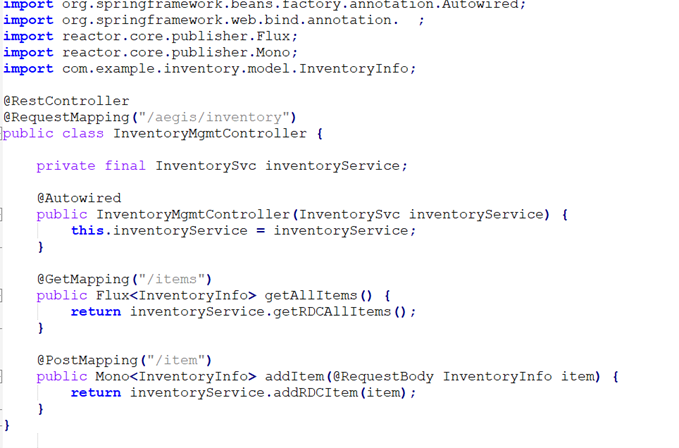
InventoryServiceImpl.java

@Entity
public class InventoryInfo {
@Id
@GeneratedValue(strategy = GenerationType.IDENTITY)
private Long id;
private String itemName;
private int qty;
// Getters and Setters
}
InventoryRepo.java
@Repository
public interface InventoryRepoextends JpaRepository<Inventory, Long> {
}

Order Processing Logic
AegisOrderProcessingApplication.java
@SpringBootApplication
@EnableBinding(OrderStreamProcessor.class)
public class AegisOrderProcessingApplication {
public static void main(String[] args) {
SpringApplication.run(AegisOrderProcessingApplication.class, args);
}
}
AegisOrderController.java

AegisOrderService.java

Send command for Processing Order:


- java -> You can define on your own depending upon the business use cases
AegisOrderStreamProcessor.java

RobotStatusController.java

RobotStatusService.java

- RobotStatusEvent.java: Define your model class fields according to your business use cases
AegisRobotStreamProcessor.java

AegisNotificationApplication.java
@SpringBootApplication
public class AegisNotificationApplication {
//main method here
}
AegisNotificationController.java

AegisNotificationSvc.java
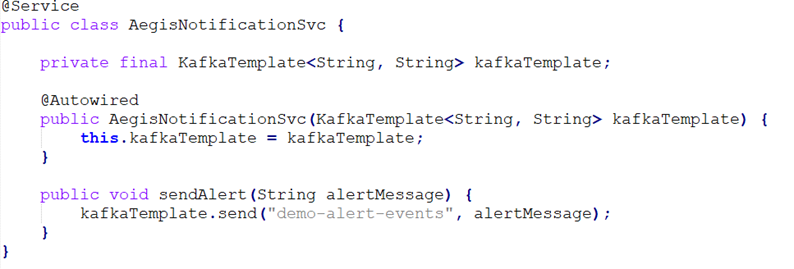
- In our warehouse automation system, “OrderService” identifies the products available in “InventoryService” and instructs the robot to select the products to order via “RobotControlService”. “RobotControlService” uses Spring Cloud Stream’s “StreamBridge” feature to send commands to Kafka topics to enable instant communication.
- The company uses microservices and Kafka to provide a large-scale and cost-effective solution for product management. The system is designed to process large amounts of information and speed up the process of order fulfilment.
- By integrating robotics and real-time data processing, product operations become more efficient. For warehouse automation systems, orders can be fulfilled instantly and robots can be dispatched immediately.
FAQs: Example implementation with Spring Boot Microservices for warehouse efficiency with real-time Robotics Automation
- What is the robotics automation process?
- Explain the system design of the Warehouse Management system
- What are key design considerations for building an advanced real-time Robotics Automation with Spring Boot Microservices?
- Implement microservice-based robotics automation for warehouse management.







